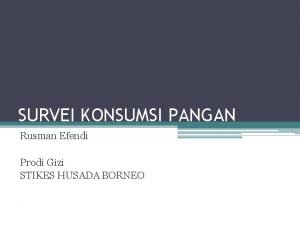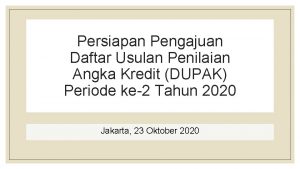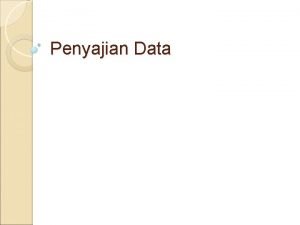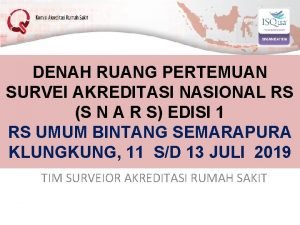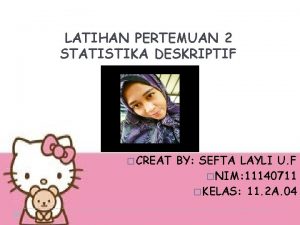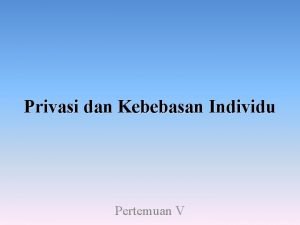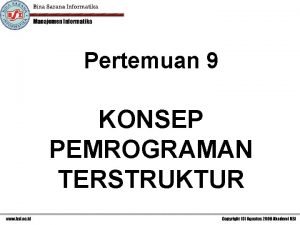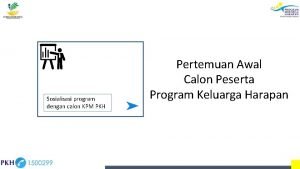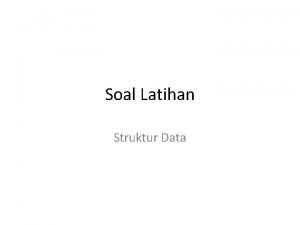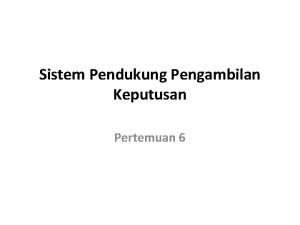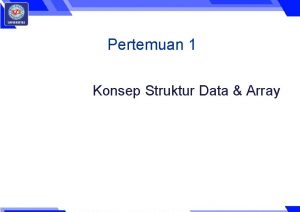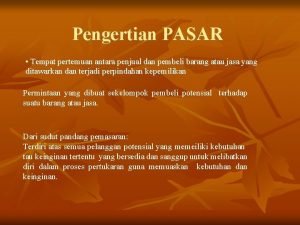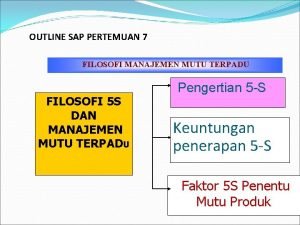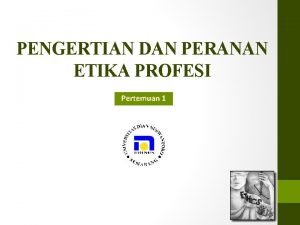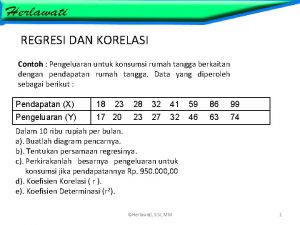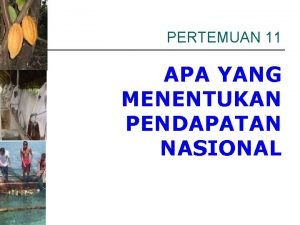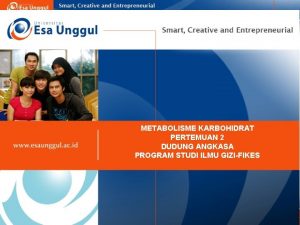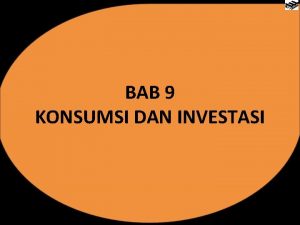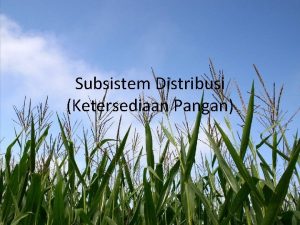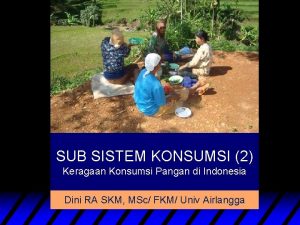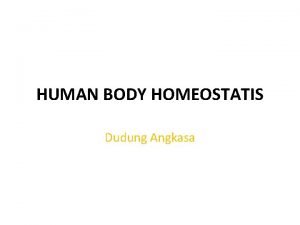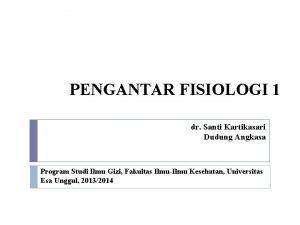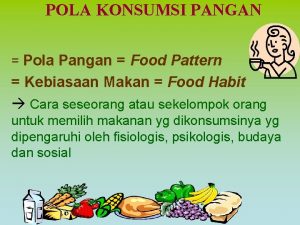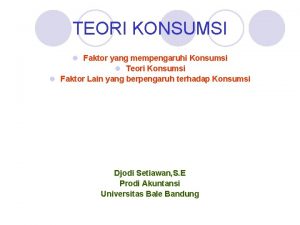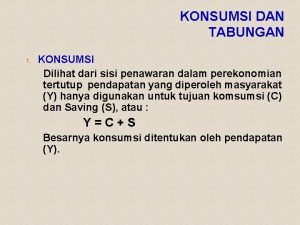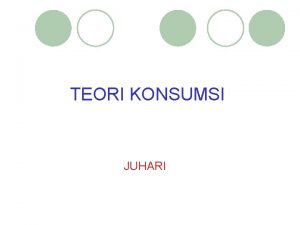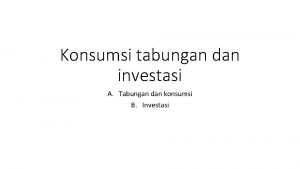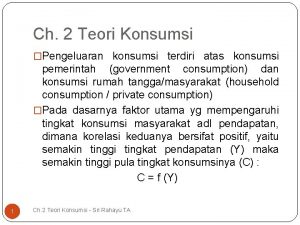SURVEY KONSUMSI PANGAN PERTEMUAN 1 DUDUNG ANGKASA PROGRAM




































- Slides: 36

SURVEY KONSUMSI PANGAN PERTEMUAN 1 DUDUNG ANGKASA PROGRAM STUDI ILMU GIZI-FIKES

VISI DAN MISI UNIVERSITAS ESA UNGGUL

KEMAMPUAN AKHIR YANG DIHARAPKAN Mahasiswa dapat menjelaskan fungsi dan informasi yang didapatkan dari survey konsumsi pangan

SURVEY KONSUMSI PANGAN Presented by: Dudung Angkasa

KONTRAK PERKULIAHAN (1/2) Nama MK SKS Pengampu Buku wajib : Survey Konsumsi Pangan : 2 sks (1 -1), ada praktikum, tidak ada online : Dudung Angkasa dan TIM : § Gibson, R. S. , 2005. Principles of nutritional assessment. Oxford university press, USA. Buku/journal tambahan § National Research Council, 1989. Diet and health: implications for reducing chronic disease risk. National Academies Press. § FAO. 2004. Uses of Food Consumption and Anthropometric Surveys in the Caribbean. Rome. Italy

KONTRAK PERKULIAHAN (2/2) Capaian Pembelajaran Mahasiswa mampu mengetahui fungsi survey konsumsi pangan Mahasiswa mampu memahami kelebihan dan kekurangan metode-metode survey konsumsi pangan Mahasiswa mampu memilih metode survey konsumsi pangan yang tepat sesuai tujuan penelitian Mahasiswa mampu melakukan validasi relatif antar metode asupan

TOTAL DIET STUDY (FDA) CFSAN/Office of Analytics and Outreach The Total Diet Study (TDS) is an ongoing FDA program that monitors levels of about 800 contaminants and nutrients in the average U. S. diet; the number varies slightly from year to year. To conduct the study, we buy, prepare, and analyze about 280 kinds of foods and beverages from representative areas of the country, four times a year. Using these data, we estimate how much of the contaminants and nutrients the entire U. S. population, some subpopulations, and each person consumes annually, on average. Because eating patterns may change over time, we update the list of foods to be analyzed about every 10 years; for example, we revise the list of foods to be tested, to account for trends in what consumers eat, and we use current data on how much of those foods consumers eat. FDA uses the TDS results in various ways; for example, along with other sources, they suggest potential areas of focus for our food-safety and nutrition programs. https: //www. fda. gov/foodscienceresearch/totaldietstudy/default. htm




OUTLINES The purposes and rationale for dietary assessment Level of Food Consumption Data

INTRODUCTION (1/2) Dietary assessment § First sign of any nutritional deficiency § Predict possible nutrient def § Confirmed by biochemical, clinical and anthrop § Useful for developing food-based dietary guidelines / intervention

INTRODUCTION (2/2) The purposes of food consumption surveys are: § to identify, predict and detect chronic or acute food and nutritional problems; § to target population groups for both short-term relief efforts and longer-term policy and programme development; § to plan and implement food and nutritional programmes and interventions; § to monitor changes and evaluate the impact of interventions and programmes.


MAJOR REASONS FOR MEASURING DIET Assess and monitor food and nutrient intake Formulate and evaluate gov health and agricultural policy Epidemiological research: diet-health Assist in commercial purposes

LEVEL OF FOOD CONSUMPTION DATA (1/2) National level § FBS § tracking trends in food supply § Expressed as per capita Households § Food account, inventories and household recall § Comparing food availability among diff communities, geographic area, socio-economic group § Tracking dietary change § But, no data on individual members distribution

LEVEL OF FOOD CONSUMPTION DATA (2/2) Group/Individual § Describe diff in intake of food and nutrients between subgroups § Depend on the ability of subject to provide accurate information § e. g food records, 24 -hours recalls, FFQ etc.

HOUSEHOLDS Food Account § Record detail of food quantities: purchasing, home produced, gift, and from other sources § No account of food stock is taken Inventory Method § Similary to food account but consider the stored food Household record § The foods presented for consumption to HH members are weighed or estimated in household measures (URT) § Appropriate for home produce population e. g farmer

INDIVIDUALS (1/4) Daily food consumption (food record & 24 H recall) and ‘usual’/average food consumption (diet history & FFQ) Food records or diary § measured at the time of eating § food intake is quantified by estimation or using household measures § Might be self reported § Usually ranging from 1 to 7 days § If food are weighed food record

FOOD RECORD VS WEIGHED FOOD RECORD Food Record § § § Use HH measurer (URT): amount of food and leftovers Researchers quantify the measure by volume and weight Preferred by researcher for group intake data Less accurate than WFR Less burden than WFR high cooperation WFR § § § Use scale or computerized tecnique More accurate than FR Preferred by some researcher for individual data Requires a greater degree of cooperation Costly scale

STRENGTH VS LIMITATION • Strengths • Does not depend on memory • Can provide detail memory • Can provide about eating habits • Multiple-day data more representative for usual diet • Reasonably valid up to 5 days • Limitation • Requires high degree of cooperation • Response burden can result in low response • Subject must be literate • Take more time to obtain data • Act of recording may alter diet • Analysis is labor intensive and expensive

EXAMPLE OF FOOD RECORD

INDIVIDUALS (2/4) 24 -hour recall § Asking subject to recall and describe all intakes of food and drink in the previous 24 hour § Required a trained fieldworker/dietitian/nutritionist (interview, asses portion, detail of food) § Cheap and easy but prone to reporting errors, including bias or inaccurate recall of food intakes and portion sizes

STRENGTH VS LIMITATION Strengths § Inexpensive; Easy to administer § Provide detailed information on type of food § Low respondent burden; Probability sampling possible § Can be used to estimate nutrient intake of groups § Multiple recalls estimate nutrient intake of individual § More objective than dietary history § Does not alter usual diet; Useful in clinical setting • Limitation • Single recall not representative of usual intake • Under/over reporting • Relies on memory • Omission of dressing, sauces, and beverage can lead to low estimate of energy intake • Data entry can be labor intensive

INDIVIDUALS (3/4) Food frequency questionnaire (FFQ) § Provide information about how often certain foods or food from given food groups, were eaten during a time interval in the past § Might be self-administered § Food list from a few questions was used to capture intake of selected foods and nutrients § The frequency can be open-ended or multiple choice § Simpler and quicker administration and processing, and subsequently lower costs as well as less burden § To quantify SQ-FFQ § Inaccuracies inadequate listing of possible foods, error in estimating portion and the usual frequency of food consumption

STRENGTH VS LIMITATION Strengths § Can be self-administered but better if trained personal did § Machine readable § Modest demand on time and energy of respondent § Generate estimate usual intake than a few diet records § Relatively inexpensive for large sample sizes § Considered by some researcher as the method of choice to asses on dietdisease relationship • Limitation • Limited food list must be representative of the most common food consumed by respondent • Short questionnaire are faster and easier but less comprehensive • Longer may be tedious to complete • Culturally sensitive failure to include unique food under estimate • Depend on the ability of subject to describe food




INDIVIDUALS (4/4) Diet History § Assess individual usual dietary intake over an extended period of time (a month, a year) § It is originally developed by Burke (1940) § § Collect general information about respondent’s health Question about his/her usual eating pattern Perform a cross-check on the data given in step 2 Have the respondent to complete a 3 -day food record § Asking for number of meals eaten per day, appetite, food dislike, presence or absence of nausea and vomiting, use of supplement, cigarette smoking, habit related to sleep, rest, work, and exercise, etc § Followed by a 24 H food recall

STRENGTH VS LIMITATION Strengths § Assess usual nutrient intake § Can detect seasonal change § Data on all nutrient can be obtained § Can correlate well with biochemical measures • Limitation • Lengthy interview process • Requires highly trained interviewers • Difficult and expensive to code • May tend to overestimate nutrient intake • Requires cooperative respondent with ability to recall usual diet

DDS (DIETARY DIVERSITY SCORE) Has been used as simple measure of diet quality Some studies showed HH DDS correlated to dietary energy availability Individual DDS + correlated with adequacy of micronutrient intake


DUPLICATE FOOD COLLECTIONS Participant place identical portion of all foods and beverages consumed Then chemically analyzed at laboratory Handling with refrigeration to avoid microbiological decomposition

STRENGTH VS LIMITATION Strengths § Can provide more accurate measurment of actual nutrient intake than calculation of FCT • Limitation • Expense and effort of preparing more food • Effort and time to collect duplicate samples • May underestimate usual intake

THANK YOU
 Dudung angkasa
Dudung angkasa Makalah survei konsumsi pangan
Makalah survei konsumsi pangan Tugas pertemuan 9 metode perancangan program
Tugas pertemuan 9 metode perancangan program Angkasa jfaa
Angkasa jfaa Gudang gapura angkasa cengkareng
Gudang gapura angkasa cengkareng Bible
Bible Contoh kalimat majemuk setara menguatkan
Contoh kalimat majemuk setara menguatkan Primary abcd
Primary abcd Diagram batang bertingkat
Diagram batang bertingkat 4 pendekatan pendidikan multikultural
4 pendekatan pendidikan multikultural Pertemuan multikultural
Pertemuan multikultural Denah ruang pertemuan
Denah ruang pertemuan Pleonasme adalah
Pleonasme adalah Tugas statistika pertemuan 2
Tugas statistika pertemuan 2 Pada pertemuan kali ini kita
Pada pertemuan kali ini kita Pertemuan ini
Pertemuan ini Pertemuan 9
Pertemuan 9 Susunan acara pkh
Susunan acara pkh Contoh soal graph struktur data
Contoh soal graph struktur data Spk latihan pertemuan 6
Spk latihan pertemuan 6 Sel adalah pertemuan antara titik-titik dan titik-titik
Sel adalah pertemuan antara titik-titik dan titik-titik Deklarasi array x adalah
Deklarasi array x adalah Tipe data int memiliki nilai jangkauan antara.
Tipe data int memiliki nilai jangkauan antara. Sell adalah pertemuan antara
Sell adalah pertemuan antara Sukrosa
Sukrosa Logo pertemuan
Logo pertemuan Pertemuan permintaan barang dan jasa
Pertemuan permintaan barang dan jasa Pengertian etiket
Pengertian etiket Jpsm courses
Jpsm courses Metode-metode survei konsumsi makanan
Metode-metode survei konsumsi makanan Peta konsep perencanaan usaha budidaya ikan konsumsi
Peta konsep perencanaan usaha budidaya ikan konsumsi Apa yang dimaksud komoditas ikan konsumsi
Apa yang dimaksud komoditas ikan konsumsi Budidaya ikan konsumsi bertujuan untuk
Budidaya ikan konsumsi bertujuan untuk Indikator konsumsi
Indikator konsumsi Fungsi konsumsi dan tabungan
Fungsi konsumsi dan tabungan Contoh pengeluaran konsumsi rumah tangga
Contoh pengeluaran konsumsi rumah tangga Rumus fungsi konsumsi
Rumus fungsi konsumsi

